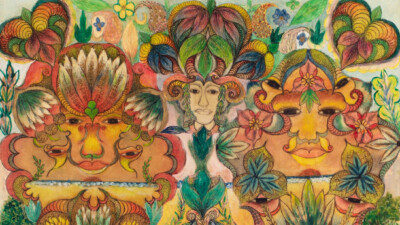Minnie Evans

Minnie Evans
Quick Facts
Biography
Minnie Evans was an influential American folk artist celebrated for her visionary and vividly colored works. Recognized as one of the most distinctive self-taught artists of the twentieth century, Minnie Evans captivated art enthusiasts with her imaginative use of patterns, symbolism, and natural forms.
Early Life
Minnie Evans was born on December 12, 1892, in Long Creek, North Carolina, United States. Raised primarily in Wilmington, North Carolina, by her grandmother, Evans experienced a modest upbringing shaped by family and community. Her early life in the rural South would later fuel the botanical and mystical themes that became central to her artwork.
Career and Artistic Journey
Minnie Evans began creating art seriously in her forties, inspired by vivid dreams and visions that she described as spiritual messages. Her career as an artist blossomed while she worked as a gatekeeper at Airlie Gardens in Wilmington. During quiet moments at work, she would sketch with colored pencils and crayons, often drawing inspiration from the lush surroundings of the gardens. Her artwork, characterized by intricate patterns, fantastical faces, and vibrant flora, soon gained attention from local patrons and art historians. Minnie Evans’ signature style combined elements of African, Caribbean, and Christian symbolism, resulting in deeply personal and spiritual compositions.
Evans’ work was first exhibited in 1961, and she soon attracted national recognition. Her art has been featured in major exhibitions, including at the Whitney Museum of American Art and the North Carolina Museum of Art, solidifying her legacy within the American folk art movement. For those interested in exploring similar visionary artists, the work of Bill Traylor and Howard Finster provides a fascinating parallel.
Achievements and Legacy
Minnie Evans is best known for her dreamlike, intricate drawings and paintings that reflect both her personal spiritual visions and the influence of nature. Her most popular work includes pieces such as “Shell Flowers” and “The Face of Christ.” Evans’ contributions to American folk art have inspired generations of artists and collectors, and her legacy continues to grow through museum collections and scholarly research. In 1994, the Minnie Evans Bottle Chapel was dedicated in her honor at Airlie Gardens, serving as a testament to her enduring impact.
Personal Life
Minnie Evans balanced her artistic pursuits with family responsibilities, working various jobs throughout her life to support her household. She married Julius Caesar Evans and raised several children in Wilmington. Despite facing economic and social challenges, Evans’ unwavering commitment to her art and faith was evident in both her personal and creative life.
Conclusion
Minnie Evans remains a pivotal figure in the history of American art, celebrated for her unique vision and transformative contributions to folk art. Her legacy is reflected not only in her captivating artworks but also in the inspiration she provides to self-taught artists and dreamers everywhere. Learn more about the American folk art movement and other influential artists by exploring related topics such as self-taught visionary art and the cultural history of the Southern United States.
Detailed Information
| Full Name | Minnie Eva Jones Evans |
| Gender | Female |
| Residence | Wilmington, North Carolina, United States |
| Marital Status | Married |
| Mother | Mary Jones |
| Years Active | 1940s-1980s |
| Known For | Visionary folk art, dream-inspired paintings |
| Major Achievements | Featured at Whitney Museum of American Art, Minnie Evans Bottle Chapel at Airlie Gardens |
| Income Sources | Art sales, exhibitions |


